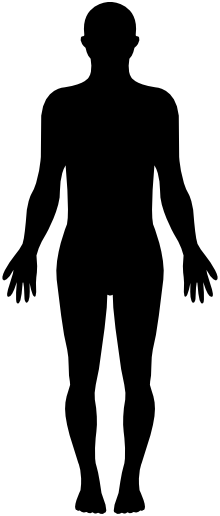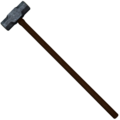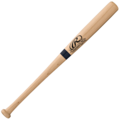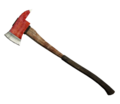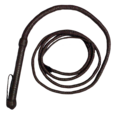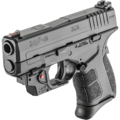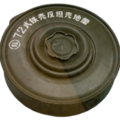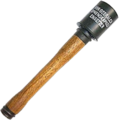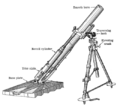- Knife: A knife is a tool with a cutting edge or blade often attached to a handle or hilt. One of the earliest tools used by mankind, knives appeared at least two-and-a-half million years ago, as evidenced by the Oldowan tools. Originally made of wood, bone, and stone (such as flint and obsidian), over the centuries, in step with improvements in both metallurgy and manufacturing, knife blades have been made from copper, bronze, iron, steel, ceramic, and titanium. Most modern knives have either fixed or folding blades; blade patterns and styles vary by maker and country of origin.
- Sledgehammer: A sledgehammer is a tool with a large, flat, often metal head, attached to a long handle. The long handle combined with a heavy head allows the sledgehammer to gather momentum during a swing and apply a large force compared to hammers designed to drive nails. Along with the mallet, it shares the ability to distribute force over a wide area. This is in contrast to other types of hammers, which concentrate force in a relatively small area.
- Crowbar: A crowbar, also called a wrecking bar, pry bar or prybar, pinch-bar, or occasionally a prise bar or prisebar, colloquially, in Britain and Australia sometimes called a jimmy, gooseneck, or pig foot, is a tool consisting of a metal bar with a single curved end and flattened points, often with a small fissure on one or both ends for removing nails or to force apart two objects. Crowbars are commonly used to open nailed wooden crates or pry apart boards. In mining, crowbars have been used to break and remove rock, but not as much in modern mining.
- Katana: A katana is a Japanese sword characterized by a curved, single-edged blade with a circular or squared guard and long grip to accommodate two hands. It was used by the samurai of ancient and feudal Japan.
- Baseball Bat: A baseball bat is a smooth wooden or metal club used in the sport of baseball to hit the ball after it is thrown by the pitcher. By regulation it may be no more than 2.75 inches (7.0 cm) in diameter at the thickest part and no more than 42 inches (1.067 m) in length. Although historically bats approaching 3 pounds (1.4 kg) were swung, today bats of 33 ounces (0.94 kg) are common, topping out at 34 ounces (0.96 kg) to 36 ounces (1.0 kg).
- Brass Knuckles: Brass knuckles are "fist-load weapons" used in hand-to-hand combat. Brass knuckles are pieces of metal shaped to fit around the knuckles. Despite their name, they are often made from other metals, plastics or carbon fibers. Designed to preserve and concentrate a punch's force by directing it toward a harder and smaller contact area, they result in increased tissue disruption, including an increased likelihood of fracturing the intended target bones on impact. The extended and rounded palm grip also spreads across the attacker's palm the counter-force that would otherwise be absorbed primarily by the attacker's fingers, reducing the likelihood of damage to the attacker's fingers.
- Axe: An axe is an implement that has been used for millennia to shape, split and cut wood, to harvest timber, as a weapon, and as a ceremonial or heraldic symbol. The axe has many forms and specialised uses but generally consists of an axe head with a handle, or helve. Before the modern axe, the stone-age hand axe was used from 1.5 million years BP without a handle. It was later fastened to a wooden handle. The earliest examples of handled axes have heads of stone with some form of wooden handle attached in a method to suit the available materials and use. Axes made of copper, bronze, iron and steel appeared as these technologies developed. Axes are usually composed of a head and a handle.
- Chainsaw: A chainsaw is a portable, mechanical saw which cuts with a set of teeth attached to a rotating chain that runs along a guide bar. It is used in activities such as tree felling, limbing, bucking, pruning, cutting firebreaks in wildland fire suppression and harvesting of firewood. Chainsaws with specially designed bar and chain combinations have been developed as tools for use in chainsaw art and chainsaw mills. These specialized chainsaws are used for cutting concrete during construction developments. Chainsaws are sometimes used for cutting ice, for example, ice sculpture and winter swimming in Finland. Someone who uses a saw is a sawyer.
- Machete: A machete is a broad blade used either as an agricultural implement similar to an axe, or in combat like a long-bladed knife. The blade is typically 30 to 45 centimetres (12 to 18 in) long and usually under 3 millimetres (0.12 in) thick. In the Spanish language, the word is a diminutive form of the word macho, which was used to refer to sledgehammers. In the English language, an equivalent term is matchet, though it is less commonly used. In the English-speaking Caribbean, such as Jamaica, Barbados, Guyana, and Grenada and in Trinidad and Tobago, the term cutlass is used for these agricultural tools.
- Whip: A whip is a tool that was traditionally designed to strike animals or people to aid in guidance or exert control through pain compliance or fear of pain, although in some activities, whips can be used without inflicting pain, such as being an additional pressure aid or visual directional cue in equestrianism. Whips are generally one of two types, either a firm stick designed for direct contact, or a flexible line that requires a specialized swing to be effective and may have less precision in return for a longer reach and greater force. There are also whips that combine both a firm stick and a flexible line, such as hunting whips.
- 9mm: The 9×19mm Parabellum is a firearms cartridge that was designed by Georg Luger and introduced in 1902 by the German weapons manufacturer Deutsche Waffen- und Munitionsfabriken for its Luger semi-automatic pistol. For this reason, it is designated as the 9mm Luger by the Sporting Arms and Ammunition Manufacturers' Institute (SAAMI), and the 9 mm Luger by the Commission Internationale Permanente pour l'Epreuve des Armes à Feu Portatives (CIP). The name Parabellum is derived from the Latin: Si vis pacem, para bellum, which was the motto of DWM.
-
Trinity Bomb (Detonation)
-
-
-
-
-
-
-
-
Operation Crossroads (Detonation)
-
- Trinity: Trinity was the code name of the first detonation of a nuclear device. It was conducted by the United States Army at 5:29 a.m. on July 16, 1945, as part of the Manhattan Project. The test was conducted in the Jornada del Muerto desert about 35 miles (56 km) southeast of Socorro, New Mexico, on what was then the USAAF Alamogordo Bombing and Gunnery Range, now part of White Sands Missile Range. The only structures originally in the vicinity were the McDonald Ranch House and its ancillary buildings, which scientists used as a laboratory for testing bomb components. A base camp was constructed, and there were 425 people present on the weekend of the test.
- Fat Man: "Fat Man" was the codename for the nuclear bomb that was detonated over the Japanese city of Nagasaki by the United States on 9 August 1945. It was the second of the only two nuclear weapons ever used in warfare, the first being Little Boy, and its detonation marked the third nuclear explosion in history. It was built by scientists and engineers at Los Alamos Laboratory using plutonium from the Hanford Site, and it was dropped from the Boeing B-29 Superfortress Bockscar piloted by Major Charles Sweeney.
- Ivy Mike: Ivy Mike was the codename given to the first full-scale test of a thermonuclear device, in which part of the explosive yield comes from nuclear fusion. Ivy Mike was detonated on November 1, 1952, by the United States on the island of Elugelab in Enewetak Atoll, in the now independent island nation of the Marshall Islands, as part of Operation Ivy. It was the first full test of the Teller–Ulam design, a staged fusion device.
- Little Boy: "Little Boy" was the codename for the type of atomic bomb dropped on the Japanese city of Hiroshima on 6 August 1945 during World War II. It was the first nuclear weapon used in warfare. The bomb was dropped by the Boeing B-29 Superfortress Enola Gay piloted by Colonel Paul W. Tibbets, Jr., commander of the 509th Composite Group of the United States Army Air Forces and Captain Robert A. Lewis. It exploded with an energy of approximately 15 kilotons of TNT and caused widespread death and destruction throughout the city. The Hiroshima bombing was the second man-made nuclear explosion in history, after the Trinity test.
- RDS-1: The RDS-1, also known as Izdeliye 501 and First Lightning, was the nuclear bomb used in the Soviet Union's first nuclear weapon test. The United States assigned it the code-name Joe-1, in reference to Joseph Stalin. It was detonated on 29 August 1949 at 7:00 a.m., at Semipalatinsk Test Site, Kazakh Soviet Socialist Republic, after top-secret research and development as part of the Soviet atomic bomb project
- W54 Warhead: The W54 was one of the smallest nuclear warheads deployed by the United States. It was a very compact implosion-type nuclear weapon design, designed for tactical use and had a very low yield for a nuclear weapon, in the range of 10 to 1,000 tons TNT equivalent. Its original use was in the Davy Crockett short-range rocket, but it was later adapted as a man-portable Special Atomic Demolition Munition, and later as the basis of nuclear-tipped air-to-air missiles. A later development was the W72, which were rebuilt W54s used with the AGM-62 Walleye guided bomb. The W72 was in service until 1979.
- Pokhran-I: Smiling Buddha was the assigned code name of India's first successful nuclear bomb test on 18 May 1974. The bomb was detonated on the army base Pokhran Test Range (PTR), in Rajasthan, by the Indian Army under the supervision of several key Indian generals. Pokhran-I was also the first confirmed nuclear weapons test by a nation outside the five permanent members of the United Nations Security Council. Officially, the Indian Ministry of External Affairs (MEA) characterised this test as a "peaceful nuclear explosion". A series of nuclear tests was carried out in 1998 under the name Pokhran-II.
- Castle Bravo: Castle Bravo was the first in a series of high-yield thermonuclear weapon design tests conducted by the United States at Bikini Atoll, Marshall Islands, as part of Operation Castle. Detonated on March 1, 1954, the device was the most powerful nuclear device detonated by the United States and its first lithium deuteride fueled thermonuclear weapon. Castle Bravo's yield was 15 megatons of TNT, 2.5 times the predicted 6.0 megatons, due to unforeseen additional reactions involving lithium-7, which led to the unexpected radioactive contamination of areas to the east of Bikini Atoll. At the time, it was the most powerful artificial explosion in history.
- Operation Crossroads: Operation Crossroads was a pair of nuclear weapon tests conducted by the United States at Bikini Atoll in mid-1946. They were the first nuclear weapon tests since Trinity in July 1945, and the first detonations of nuclear devices since the atomic bombing of Nagasaki on August 9, 1945. The purpose of the tests was to investigate the effect of nuclear weapons on warships. The Crossroads tests were the first of many nuclear tests held in the Marshall Islands, and the first to be publicly announced beforehand and observed by an invited audience, including a large press corps. They were conducted by Joint Army/Navy Task Force One, headed by Vice Admiral William H. P. Blandy rather than by the Manhattan Project, which had developed nuclear weapons during World War II. A fleet of 95 target ships was assembled in Bikini Lagoon and hit with two detonations of Fat Man plutonium implosion-type nuclear weapons of the kind dropped on Nagasaki, each with a yield of 23 kilotons of TNT (96 TJ).
- Tsar Bomba: The Soviet RDS-220 hydrogen bomb, known to the Western nations as Tsar Bomba, was the most powerful nuclear weapon ever created. Tested on 30 October 1961 as an experimental verification of calculation principles and multi-stage thermonuclear weapon designs, it also remains the most powerful human-made explosive ever detonated. The bomb was detonated 4000 m above the Sukhoy Nos ("Dry Nose") cape of Severny Island, Novaya Zemlya, 15 km (9.3 mi) from Mityushikha Bay, north of Matochkin Strait. The detonation was secret but was detected by US Intelligence agencies. The US apparently had an instrumented KC-135R aircraft in the area of the test – close enough to have been scorched by the blast.
|
